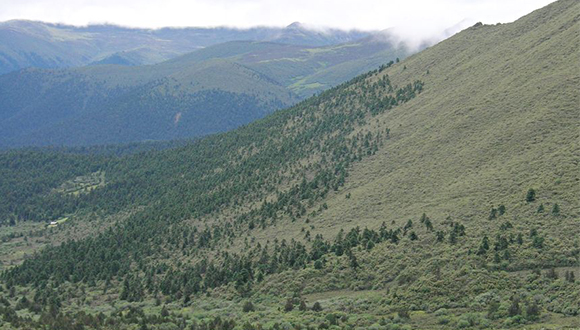The treeline in Tibet increases slower than temperatures
The forest treeline shifts upward slower than temperature increase, and it can be hindered by densification of shrubs. A number of factors influence upward forest expansion, including the particular plant species growing near trees, climate change, human activity, and terrain morphology. The Tibetan Plateau, practically devoid of human pressures, offers a pristine area for study

In the context of climate change with increasing temperatures, the upward increase of the treeline is stopped or slowed down by shrubs and bushes competing for the same resources. While to date it has been generally assumed that warming of the climate should be the primary cause for increases in forest treelines, the special virginity of the study area has led to the realization that, in addition to climatic and human factors, terrain geomorphology and biotic interactions are also important.
The study published in the scientific journal PNAS was directed by CREAF and CSIC researcher Josep Peñuelas. The results show that the increase of the forest treeline on the Tibetan Plateau – an area at about 4,900 meters above sea level, the highest point in the northern hemisphere – has been slower and more restrained than in other areas of the planet. The research reveals that at the majority of sites studied with significant bush and shrub cover and height, the upper limit of the treeline has remained stable for the past 100 years. It was only in cases where there were few bushes of small size that the forest pushed upward, to a maximum of 80 m, and so it is considered that in these cases the treeline did actually respond to temperature increases.
“Generally speaking, up to now it was thought that in alpine and sub-alpine ecosystems the upward increase of the treeline was mostly a response to warming climate since it is the temperature minimum which limits tree growth in these areas”, says the CREAF researcher. For this reason the article authors had supposed that rising temperature had increased and accelerated the establishment of trees at increasing altitudes. “With this research we have been able to understand and explain the discrepancy between the rhythm and intensity of global warming and the dynamics of the treeline observed on the Asian plateau0”, says Peñualas. Adding, “again we have shown that the key role of climate shouldn’t make us forget the role of biology”.
The forests of the Tibetan Plateau offer scientists a virgin area for study free of human activity
Being an area which is still pristine, far from ranching and other human activity, “this has allowed demonstration of the key role of biological interactions between thickets of bushes and trees”, says Josep Peñuelas. He adds that it has also been very helpful to remove the influence of humans in a study of this type, often very difficult to achieve, for example when studying the Pyrenees or the area of Montseny (Spain) which have much stronger recent histories of human pressure.
ARTICLE
Liang, E., Wang, Y., Piao, S., Lu, X., Camarero, J.J., Zhu, H., Zhu, L., Ellison, A.M., Ciais, P., Peñuelas, J. Species interactions slow warming-induced upward shifts of treelines on the Tibetan Plateau. (2016). PNAS. DOI: 10.1073/pnas.1520582113.






